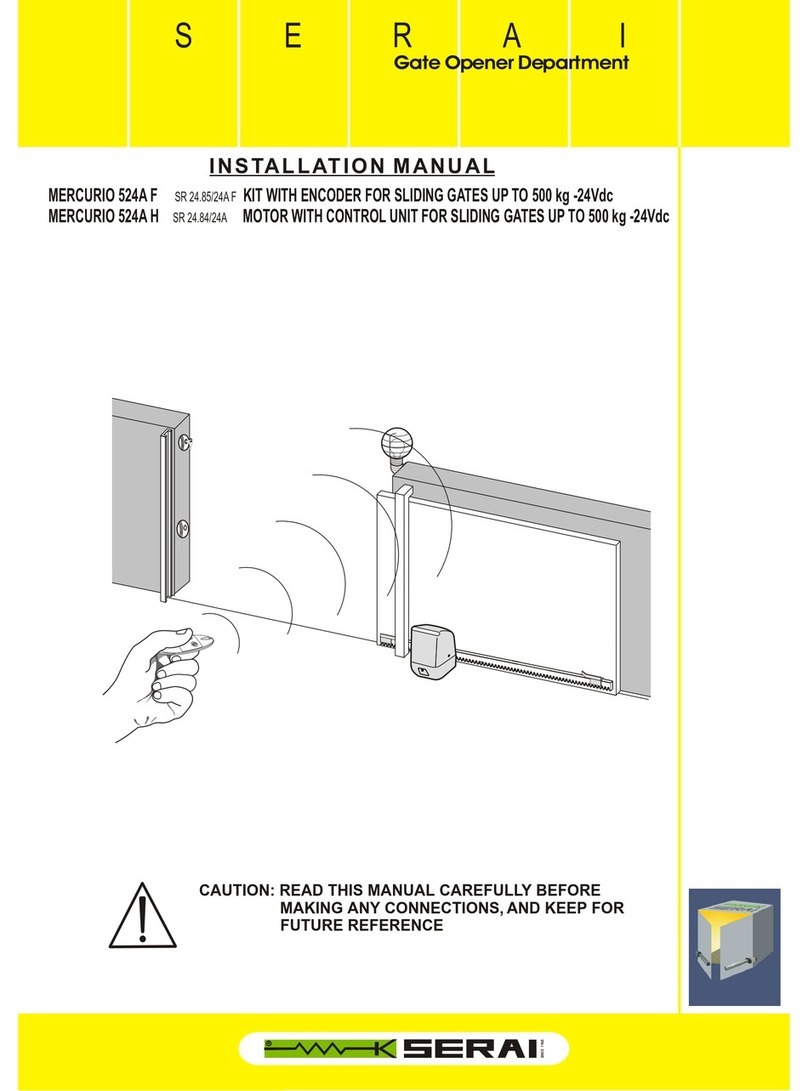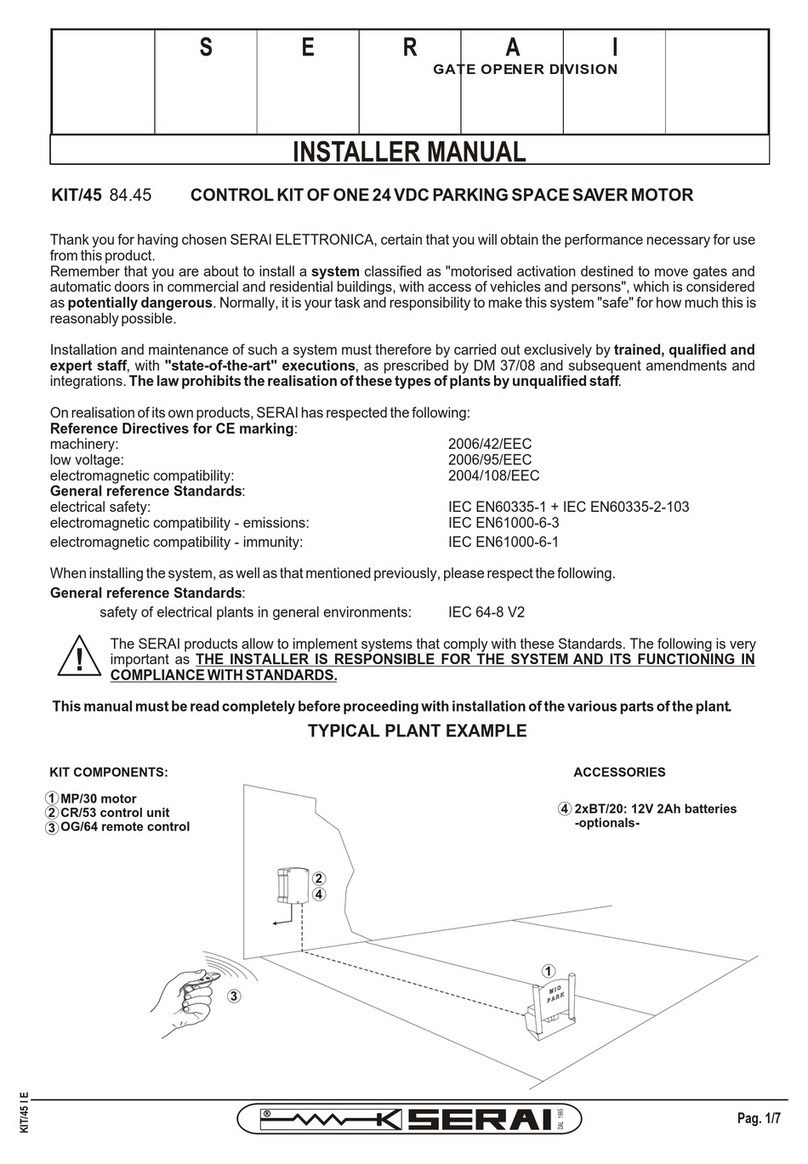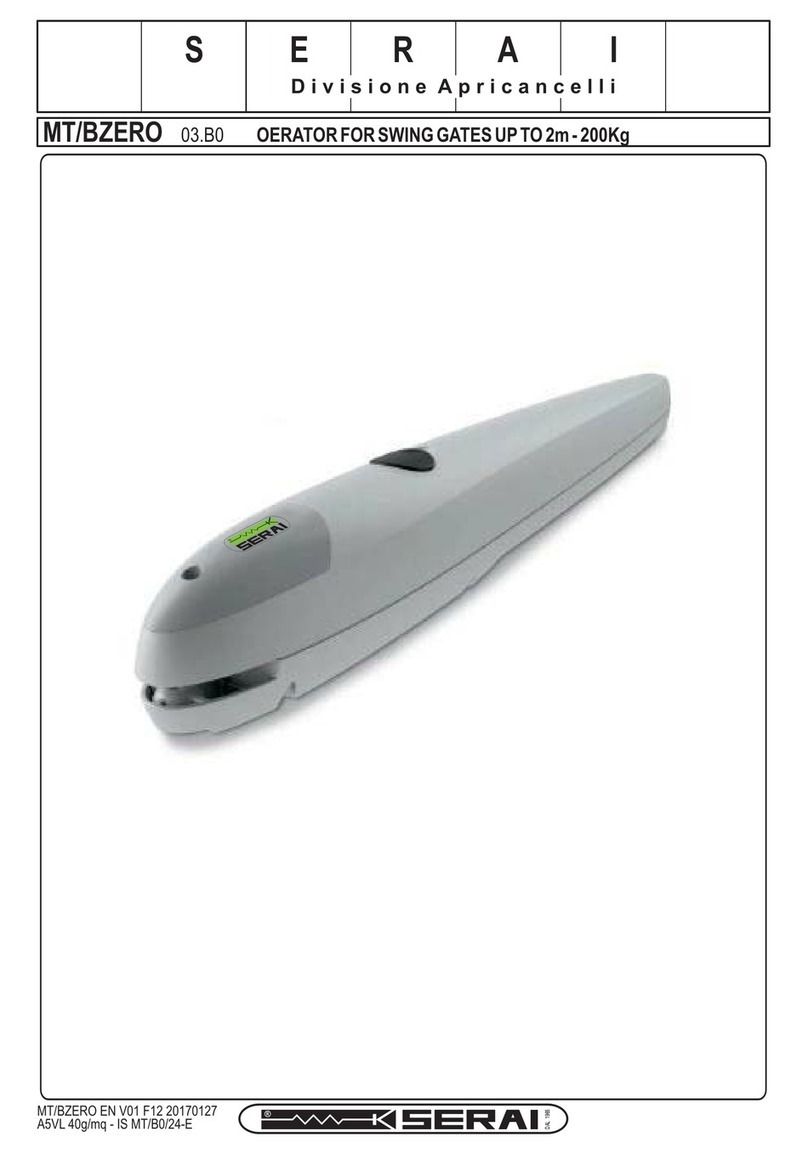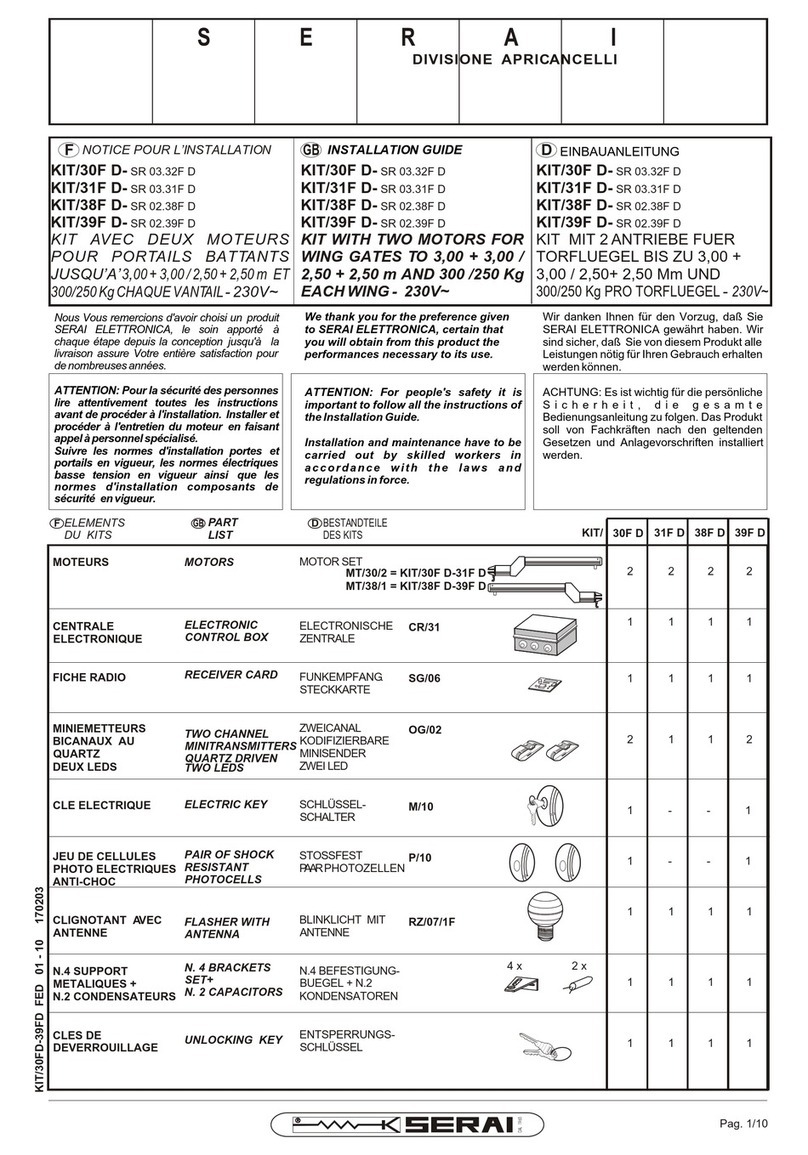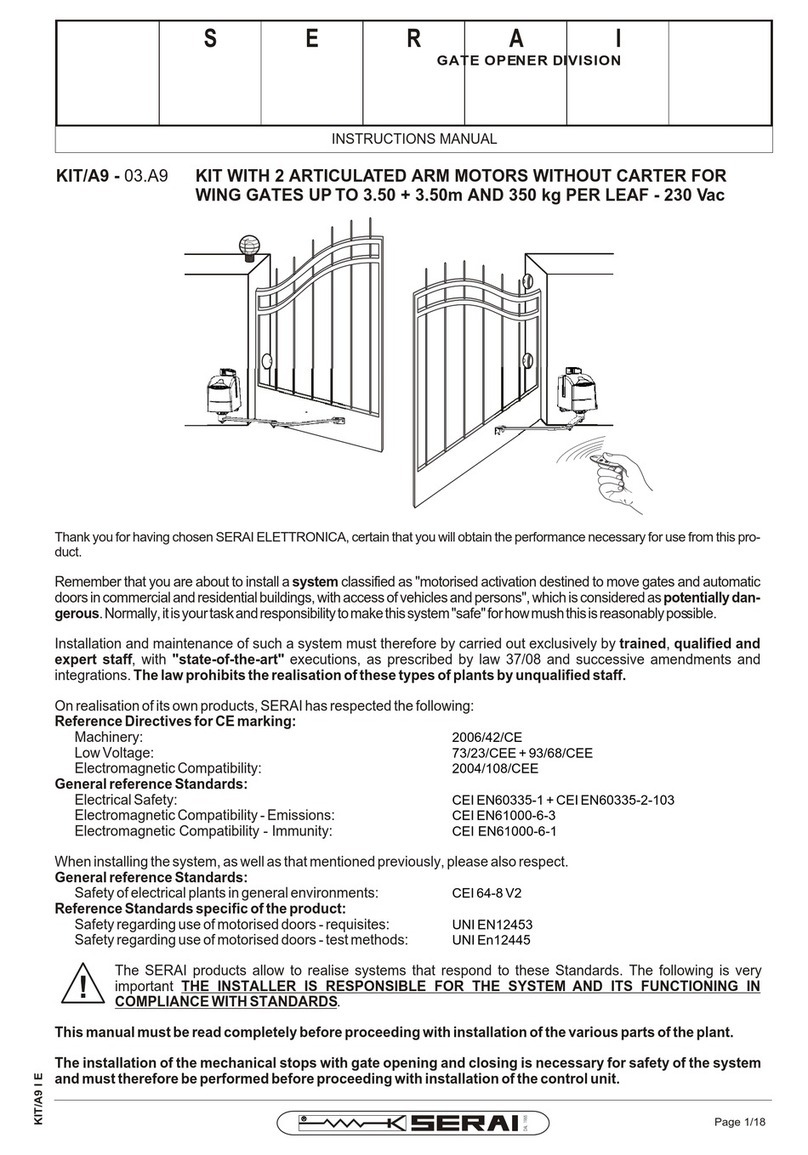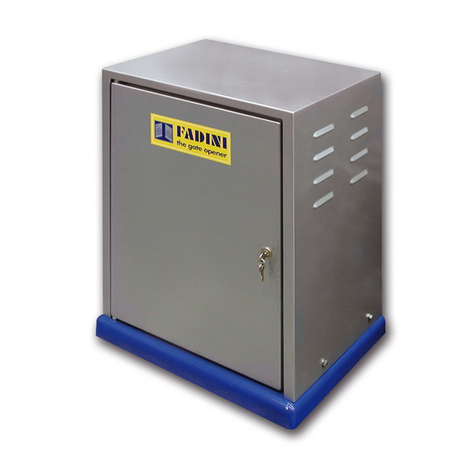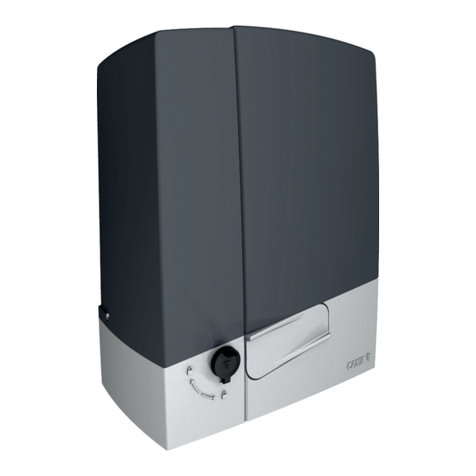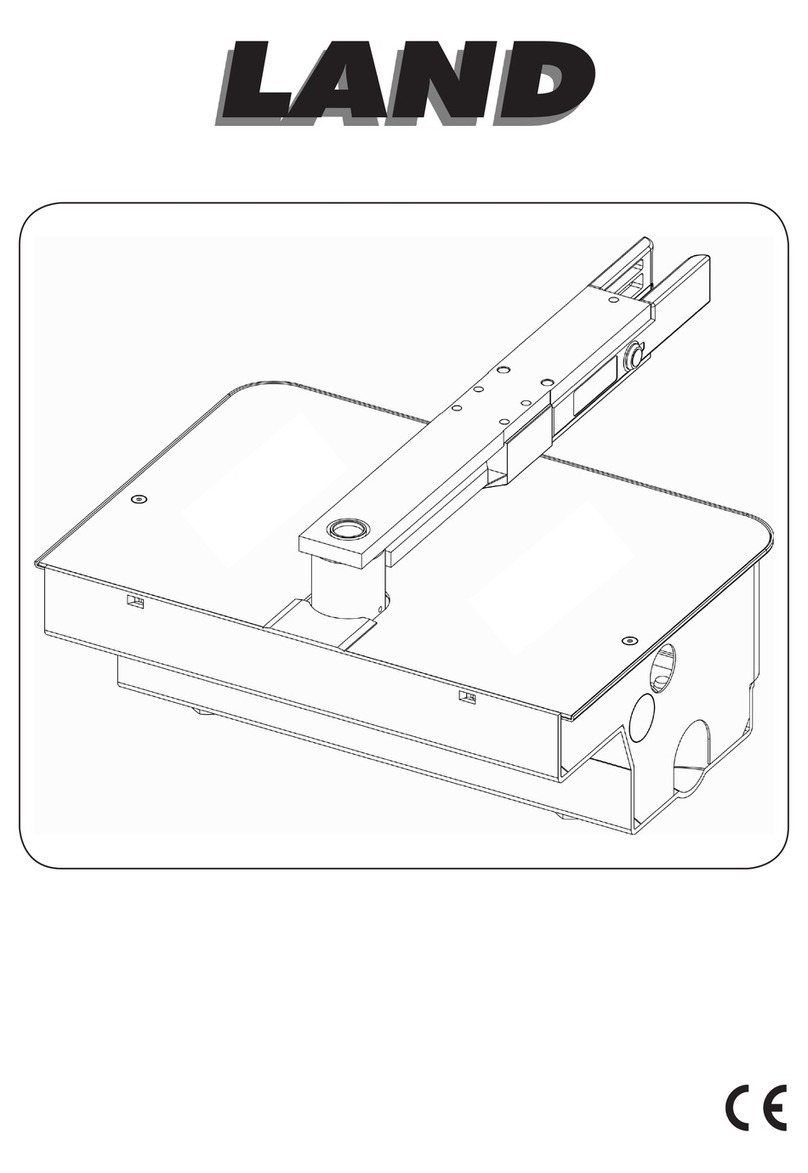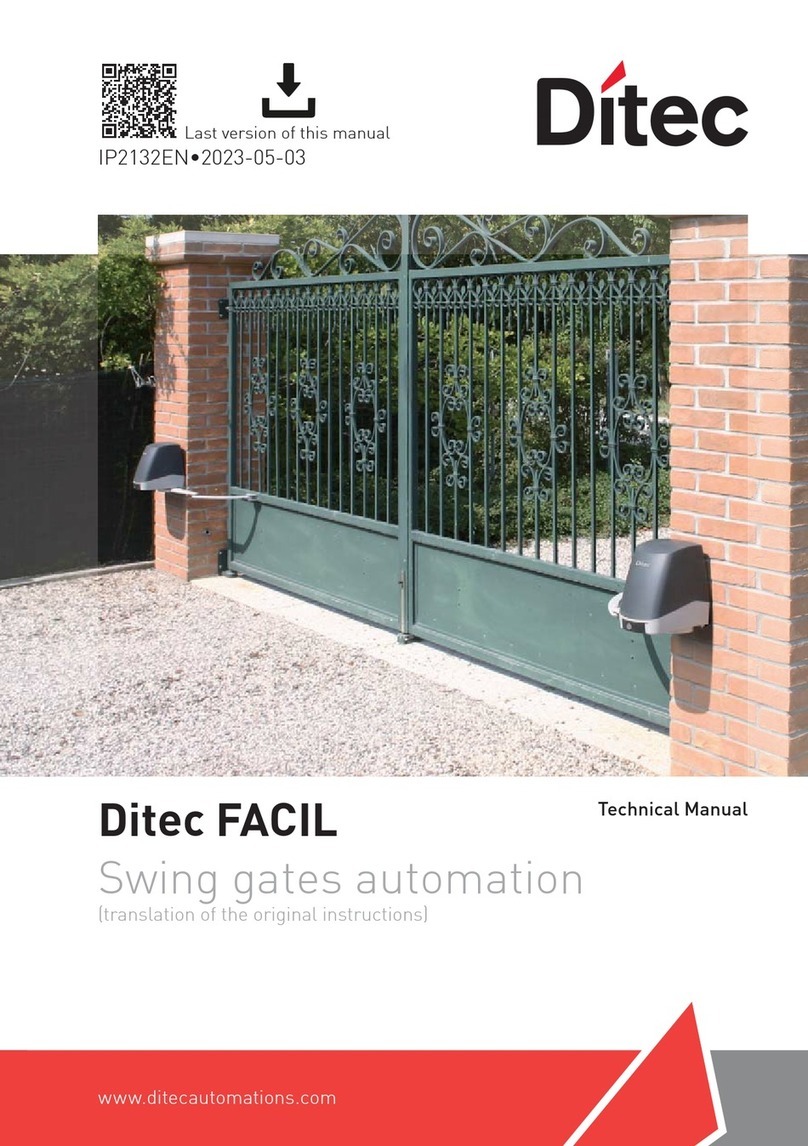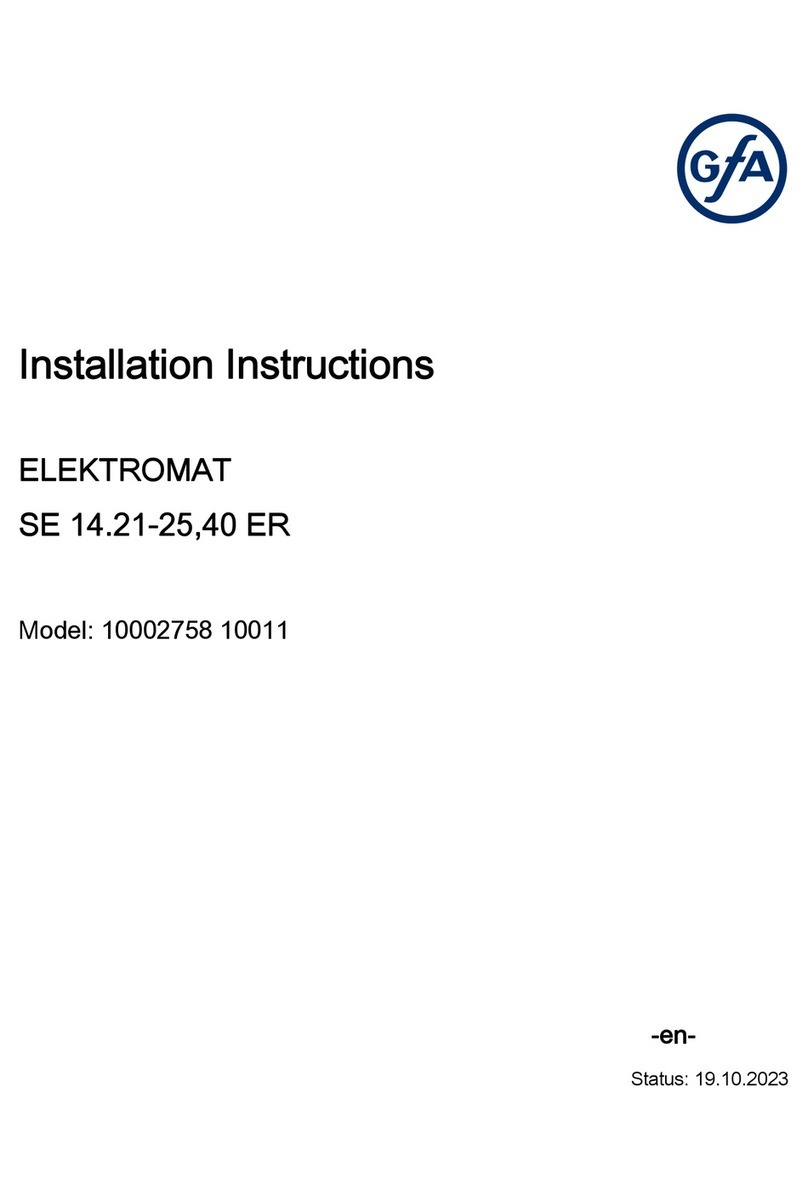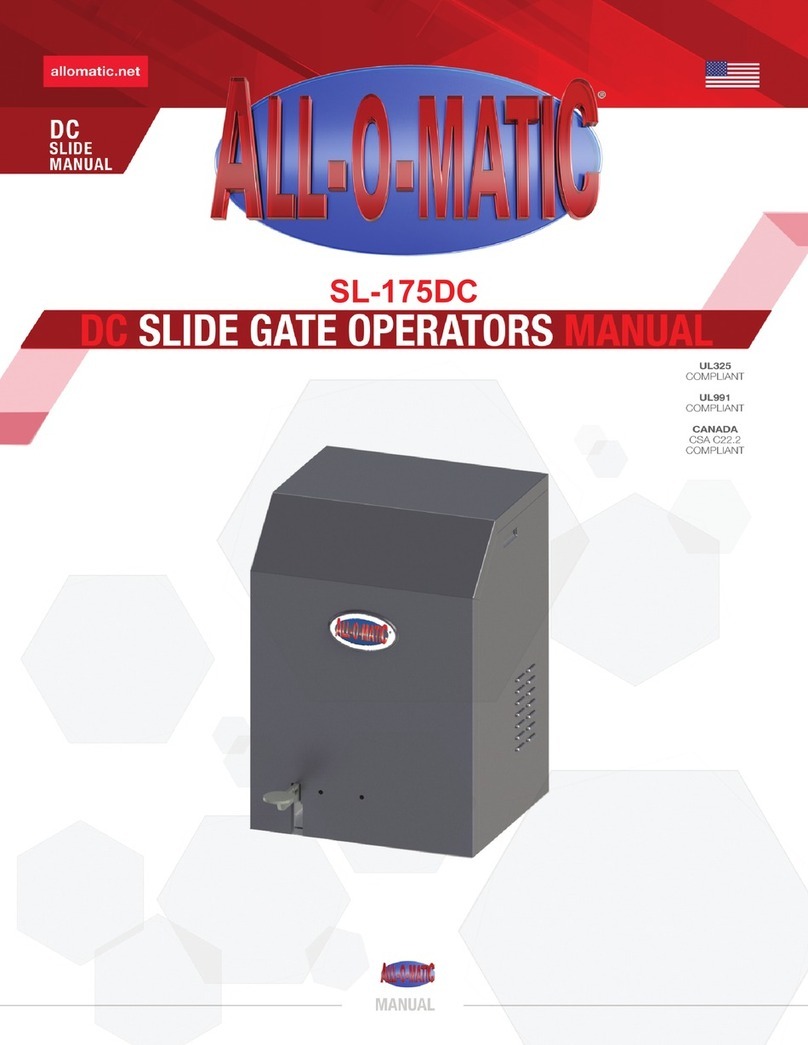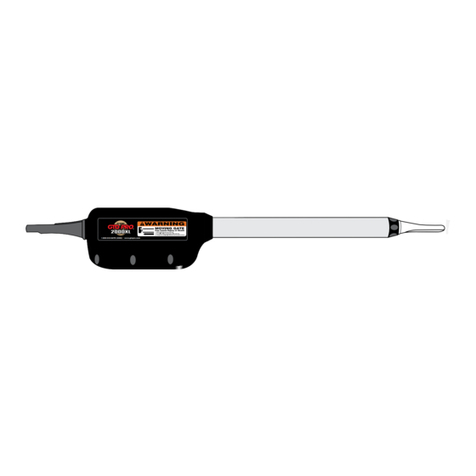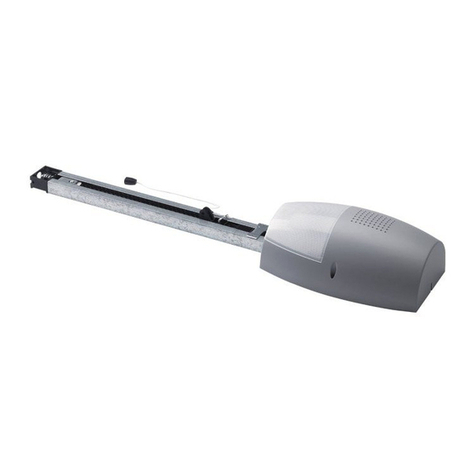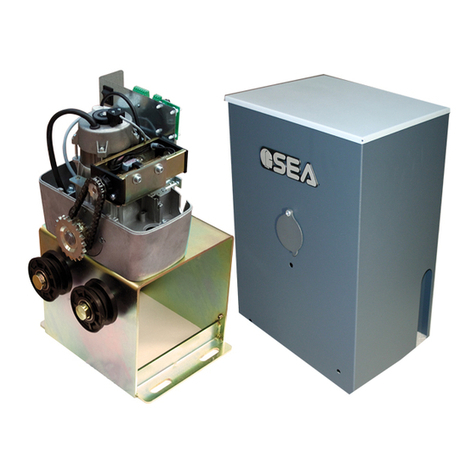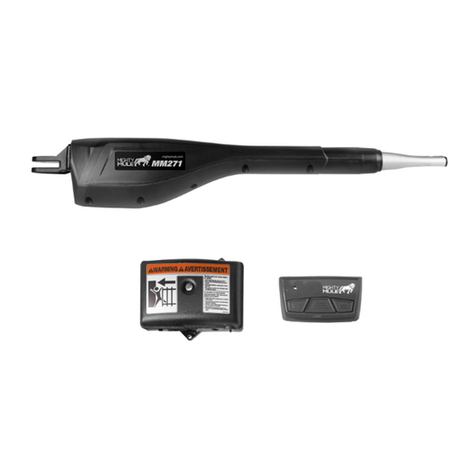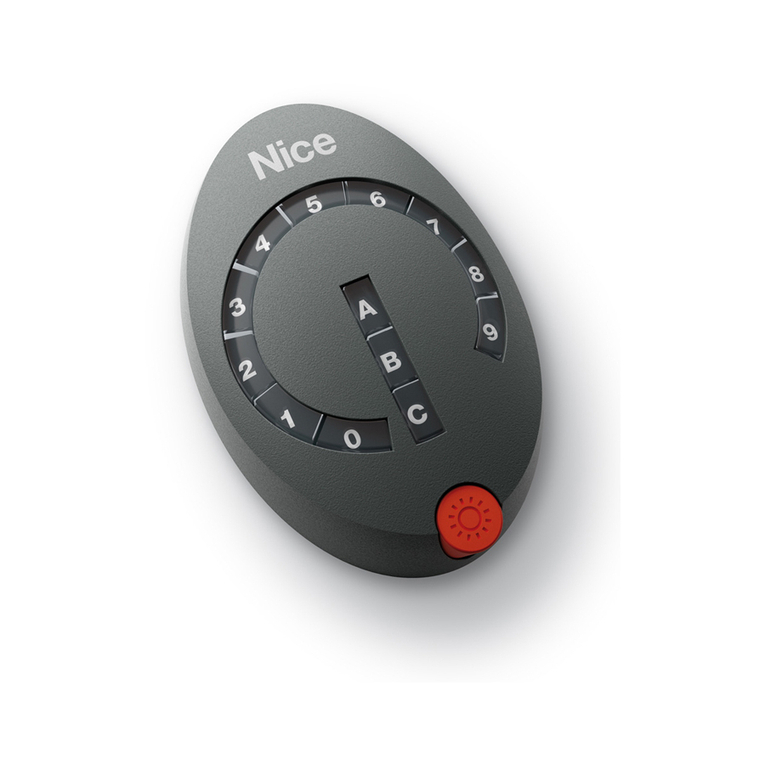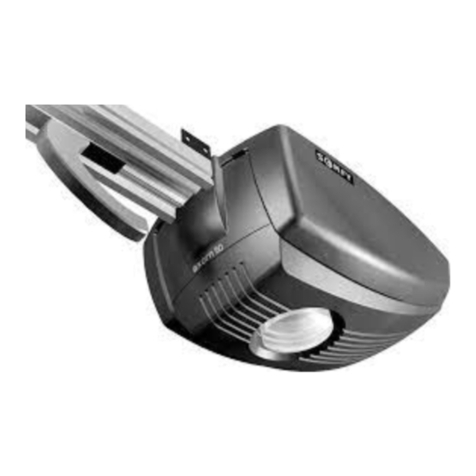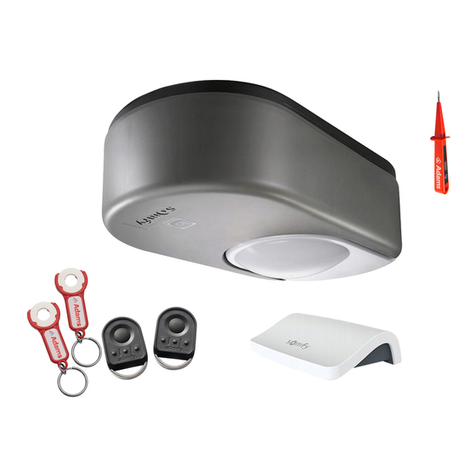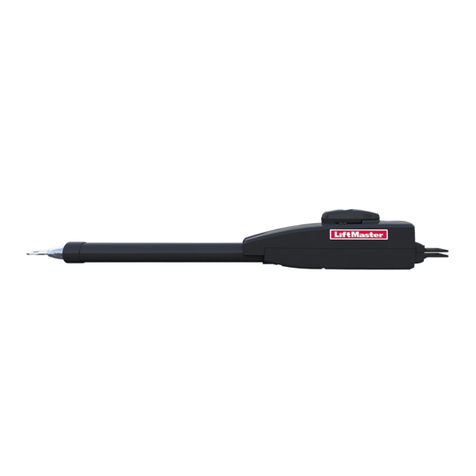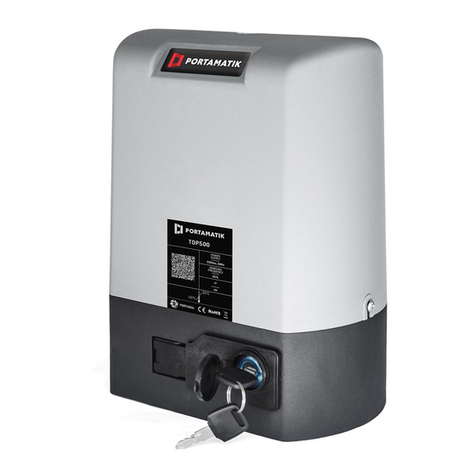Serai KIT/30 F User manual

Page 1/18
KIT/30-39F I E
!
Thank you for choosing a SERAI ELETTRONICA product, which we are confident will perform to your requirements.
Please be advised that you are about to fit a system classified as “a power-operated drive designed to move automatic ga-
tes and doors in commercial or residential buildings accessed by vehicles and persons”, and as such, the system must be
considered potentially hazardous. By law, you are responsible for rendering this equipment as “safe” as is reasonably pos-
sible.
Installation and maintenance of equipment of this kind must therefore be carried out by skilled, qualified and trained
personnel, working in a professional manner, as provided for by law n. 37/08 and any subsequent amendments and
supplements. The law in question prohibits the construction of these types of systems by non-qualified personnel.
SERAI manufacturing complies with the following legislation:
Applicable directives for the CE marking :
Machines: 2006/42/EC
Low Voltage: 2006/95/EEC
Electromagnetic Compatibility: 2004/108/EEC
General applicable standards:
Electrical Safety: IEC EN60335-1 + IEC EN60335-2-103
Electromagnetic Compatibility - Emissions: CEI EN61000-6-3
Electromagnetic Compatibility - Immunity: CEI EN61000-6-
Apart from the legislation mentioned above, you are also reminded to comply with the following standards during the
installation phase.
General applicable standards:
Safety of electrical systems in non-specialised environments: CEI 64-8 V2
Specific product standards applicable:
Safety in the use of power-operated doors - requirements: UNI EN12453
Safety in the use of power-operated doors - testing methods: UNI EN12445
SERAI products enable users to build systems which comply with these standards. This is extremely important as
THE INSTALLER IS LIABLE FOR THE SYSTEM AND FOR ENSURING ITS OPERATION COMPLIES WITH
LEGAL PROVISIONS.
This handbook must be read in full before proceeding with the installation of the various parts of thesystem.
The installation of the mechanical end stops for gate opening and closure is necessary for system safety purposes
and therefore this operation must be performed before proceeding with the installation of the control unit.
SINCE 1965
ERAIS
GATE AUTOMATION DIVISION
INSTALLATION MANUAL
KIT/30 F - SR 03.32 F - KIT WITH 2 MOTORS FOR SWING GATES UP TO 3.0 + 3.0 METERS AND
300 kg PER LEAF - 230 Vac
KIT/39 F - SR 02.39 F - KIT WITH 2 MOTORS FOR SWING GATES UP TO 2.0 + 2.0 METERS AND
200 kg PER LEAF - 230 Vac

DAL 1965
Pag. 2/18
LATERAL VIEW
60 mm 60 mm
280 mm
860 mm (MT/30/2)
660 mm (MT/38/1)
115 mm
80 mm
Attenzione!
Limitedi corsa. Non superare
Caution!
Limitof stroke. Do not exceed
Attenzione!
Limitedi corsa. Non superare
Caution!
Limitof stroke. Do not exceed
VIEW FROM BELOW
950 mm (MT/30/2)
750 mm (MT/38/1)
KIT/30F KIT/39F
COMPONENTS OF KIT
4 x 2 x
2 2
1 1
2 1
1 1
1 1
1 1
1 1
1 1
1 1
Motors
MT/30/2 = KIT/30F
MT/38/1 = KIT/39F
CR/41 Electronic control unit
with built-in receiver
OG/62 2-channel
minitransmitter with
marsupium support
M/10 Electric key
P/10 Pair of impact-resistant
photocells
RZ/20 F Flashing light with built-
in antenna, without
internal circuit for
flashing
RZ/99 L-shaped holder
N. 4 BRACKETS SET+
N. 2 CAPACITORS
UNLOCKING KEY
OVERALL DIMENSIONS OF GEARMOTOR
KIT/30-39F I E

DAL 1965
Pag. 3/18
1
230V
3 x 1,5
4 x 0,5
2 x 0,5
4 x 0,5
4 x 1,5
4 x 1,5
2 x 0,5
3 x 0,5
RG58 2 X 1,5
1
2
4
55
3
6
MT/30/2 MT/38/1
Power supply 230 V~ ±10% 50/60 Hz 230V~ ±10% - 50/60 Hz
Max. leaf length 3,00 m 2,00 m
Max. leaf weight 300 kg 200 kg
Max. opening angle 110° 110°
Max. absorption 1,6 A 1,6 A
Power 150 W 150 W
Max. torque 180 Nm 120 Nm
Max. thrust 1200 N 1200 N
Angular speed 0,09 rad/s 0,11 rad/s
Opening time for 90° 17 s 17 s
Motor force adjusted: via power supply voltage control
Capacitor 12,5µF 12,5µF
Motor thermal protection 150° 150°
Protection rating IP55 IP55
Operating temperature -20°C ÷ +60°C -20°C ÷ +60°C
Dimensions 950 x 115 x 80 mm 750 x 115 x 80 mm
Weight 9 kg 7,5 kg
4 M/10 electric key
5 Pair of P/10 photocells
6 RZ/20 F Flashing light with antenna
SYSTEM TYPE
1 MT/30/2, MT/38/1 gearmotor
2 CR/41 electronic control unit with built-in receiver
3 OG/62 2-channel minitransmitter
Advice for wiring up in non-specialised environments.
1. Fit an omnipolar switch upstream of the system, choosing one with a gap of at least 3mm between the contacts. Or,
alternatively, use a 10Athermal magnetic circuit breaker.
2. Always make connections, of any type, with the system disconnected from the power supply, i.e. with the main switch
set to OFF (symbol “0”). The control unit, in particular, must never be connected to the power supply either during the
wiring up, or when fitting any expansion boards.
3. The following cables must be used for installation of the system:
22
- for the control unit, motor and electric lock power supplies: 1.5mm section for lengths of up to 19m, 2.5mm section
for lengths of up to 31m,
22
- for the flashing light: 0.75mm section for lengths of up to 3m, 1.5mm section for lengths of up to 19m,
- for the low voltage and current lines, (e.g. for the photocells, control buttons, electromechanical key, sensitive
22
edges and other safety devices: 0.5mm section for lengths of up to 50m, 0.75mm section for lengths of up to 100m.
4. Wire up the earth connection in compliance with legal provisions.
GEARMOTOR TECHNICAL SPECIFICATIONS
The technical data refer to an ambient temperature of 25°C with intermediate force setting.
Lower operating temperatures or higher stress levels could require increased force settings. The opposite applies
for higher temperatures or lower stress levels.
KIT/30-39F I E

DAL 1965
Pag. 4/18
PILLAR
HINGE
GATE
A
60 mm 60 mm
280 mm
860 mm (MT/30/2)
660 mm (MT/38/1)
115 mm
80 mm
Attenzione!
Limitedi corsa. Non superare
Caution!
Limitof stroke. Do not exceed
Attenzione!
Limitedi corsa. Non superare
Caution!
Limitof stroke. Do not exceed
Fig. 3
950 mm (MT/30/2)
750 mm (MT/38/1)
Fig. 2
Fig. 1
BEFORE INSTALLING THE MOTORS
1- Ensure perfect right angles of the gate hinges to
enable totally smooth and balanced swing gate
movement. Otherwise the motor may be damaged
when subject to much higher levels of resistance with
respect to those specified for intended use.
2- In the maximum gate opening and closing positions,
check that two sturdy travel stops are anchored to the
ground to block the gate leafs at the end of travel Fig.
2 -. Otherwise install as necessary.
3- Ensure that the distance between the gate hinge and
post surface, marked A in fig. 2, is:
- less than 130 mm for an opening angle of 90°
- less than 110 mm for an opening angle of 100°
- less than 80 mm for an opening angle of 110°
4- The motor is supplied with the mobile pin (PM) - Fig. 3
- in the correct position for installation. However,
ensure that the distance of the mobile pin from the rear
connection point is:
- 860 mm for motors MT/30/2.
- 660 mm for motors MT/38/1.
Any distance greater than the specified value may
cause shutdown of the motor shortly before the gate
reaches the closing end stop; shorter distances will
cause a smaller opening angle than that required.
WARNING:
NEVER EXCEED THE PIN
STROKE LIMITS AS
INDICATED ON THE MOTOR
Attenzione!
Limite di corsa. Non superare
Caution!
Limit of stroke. Do not exceed
OPENING
AND CLOSING
END STOP
LATERAL VIEW
VIEW FROM BELOW
KIT/30-39F I E

DAL 1965
Pag. 5/18
Fig. 6
OPENINGANGLE 90° OPENINGANGLE 100° OPENINGANGLE 110°
B C B C B C
180 105
170 115 160 95
160 118 150 105 130 120
150 130 140 120 120 130
140 140 130 130 110 140
130 150 120 135 110 150
120 160 110 145
110 167 100 155
100 176 90 165
90 185
Warning: to ensure correct gate movement, use values in the shaded band.
The gate opening (or closing) time varies according to the selected values B and C.
C
90 mm
PM
PM
90 mm
580 mm (MT/30/2)
380mm (MT/38/1)
B
C
860 mm (MT/30/2)
660mm (MT/38/1)
B
PM
Fig. 5Fig. 4
5) Choose the opening angle and calculate distances B and C, -Fig. 4 Fig. 5 and table for bracket positioning. The
values in the grey band are recommended. The brackets can be resized (shortened or lengthened) according to
assembly requirements, and observing distances B and C.
N.B. In the case of outward opening, the overall working area of the gate is reduced due to the dimensions of the
motors. In this case installation of the motors on the upper section of the gate is recommended.
IMPORTANT : Failure to observe distances B and C specified in the table will mean that the gate starts
movement suddenly with excessive oscillations which could lead to damage to the brackets and motor.
PROVISIONAL MOTOR INSTALLATION
6- Close the gate completely. Provisionally fix the rear
bracket - Fig. 6 onto the gate post by welding or by
means of screws + plugs, observing distances B and
C. Provisionally fix the motor to the rear bracket, As
shown in Fig. 6.
7- Move the motor up against the closed leaf to
determine the front bracket welding point. Move the
motor away from the leaf.
Provisionally fix the front bracket to the gate,
observing the distance and travel limits of the mobile
pin. Insert the mobile pin in the front bracket fig. 7
then secure by means of the nut.
BRACKET POSITIONING FOR INWARD OPENING BRACKET POSITIONING FOR OUTWARD OPENING
INWARD OPENING
OUTWARD OPENING
KIT/30-39F I E
Fig. 7

DAL 1965
Pag. 6/18
Fig. 9
Fig. 8
MOTOR INSTALLATION
ON LEFT GATE WING
Fig. 10
Fig. 11
Fig. 12 Fig. 13
!!
Fig. 14 Fig. 15
8- Level the motor and tighten all screws and bolts
fully down. Fig. 8.
9- With the aid of a 17 mm wrench, turn the half-nut
on the mobile pin through half a turn to release
the motors. Fig. 9.
Check that movement is smooth. Return the
half nut of the mobile pin to the original
position. Close the gate: the motor blocks
when the gate reaches the closing end stop.
FINAL INSTALLATION
10- Remove the motor from the brackets. Weld the
front bracket in its final position. Fix the rear
bracket in its final position. Fig. 10.
11- Refit the motor.
12- Mount the lever release mechanism, as shown in
fig. 11. Remove the blank-out disk on the right
(marked internally with D) for the right leaf, and
remove the blank-out disk on the left (marked
internally with S) for the left leaf. In the hole,
insert the key block with protection cover.
Secure the hook-shaped pawl by means of the
relative nut onto the square pin of the key block.
Close the half nut of the mobile pin between the
two half-housings and secure by means of the
relative screws.
MOVING THE GATE MANUALLY IN THE EVENT
OF A POWER FAILURE
- Use the key and release lever as shown in fig.
12.
- Keeping the mobile pin released by means of the
release lever, open manually - Fig.13 -.
- To restore the gate block, simply return the
release lever and gate to the positions prior to
release, pushing the gate until it engages -
Fig.14 -.
- Return the key to the initial position to remove -
Fig. 15.
MOTOR INSTALLATION
ON RIGHT GATE WING
KIT/30-39F I E

CR/41 CONTROL UNIT INSTALLATION
Position the equipment in the vicinity of the gate, to minimise the length of cables for connection to the rest of the
system.
For further protection against atmospheric agents, position the control unit under a canopy or for improved
protection in an enclosure also fitted with two lateral walls. The equipment should also be installed at a height of at
least 1.5 meters, to keep it out of the reach of children.
CONTROL UNIT POSITIONING
The control unit leaves the factory with the cover positioned for opening from the left-hand side.
To invert the cover opening side, proceed as follows:
WARNING: This operation must be performed before
fixing the enclosure to the wall.
Insert a slotted screwdriver in the hinge fixture slot at the rear
of the base and lever the hinge connection tooth while pulling
the cover up to remove. (see Fig. 1)
Fig.1
Insert a slotted screwdriver in the hinge fixture slot on the front
of the cover and lever off the hinge connection tooth while
pulling up the hinge. (see Fig. 2)
Fig.2
Refit the hinges on the right side of the base, inserting
them in the relative seats with the connection teeth
facing the interior of the enclosure, until they click into
place (see Fig. 3).
Fig.3
SETTING THE COVER FOR OPENING TO RIGHT
!
Page 7/18
SINCE 1965
KIT/30-39F I E

CABLE INLET
For cable routing, the lower section of the enclosure is equipped with seats for cable clamps PG11 and PG 13.5 to
be punched out when required.
!
Cable routing
CAUTION: Close all inlets securely to prevent the penetration of
insects which may damage the control unit.
WALL-MOUNTING THE CONTROL UNIT
Ø 6 ÷ 8 mm
Position the equipment in the vicinity of the gate, so
that the length of the cables for connection to the rest
of the system are as short as possible.
Secure the control unit with the cable routing holes
facing downwards.
Page 8/18
NO NO YES
OPENING AND CLOSING THE BOX
When opening the box, ensure that the hinges protrude
sufficiently from the guide on the base to ensure that the cover
remains open without obstructing control unit wiring operations.
Always accompany the cover when closing until it returns
completely inside the hinges, taking care that the seal is inserted
correctly. Close the cover with the relative screws.
Advice for wiring up in non-specialised environments.
1. Fit an omnipolar switch upstream of the system, choosing one with a gap of at least
3mm between the contacts. Or, alternatively, use a 10A thermal magnetic circuit
breaker switch.
2. Make all types of connection with the system disconnected from the power, i.e. with the
main switch set to OFF (symbol “0”). The control unit, in particular, must never be
connected to the power supply either during the wiring up, or when fitting any expansion
cards.
3. The following cables must be used for installation of the system:
2
- for the control unit, motor and electric lock power supplies: 1.5mm section for lengths
2
of up to 19m, 2.5mm section for lengths of up to 31m,
22
- for the flashing light: 0.75mm section for lengths of up to 3m, 1.5mm section for
lengths of up to 19m,
- for the low voltage and current lines, (e.g. for the photocells, control buttons,
2
electromechanical key, sensitive edges and other safety devices: 0.5mm section for
2
lengths of up to 50m, 0.75mm section for lengths of up to 100m.
4. Wire up the earth connection in compliance with legal provisions.
SINCE 1965
KIT/30-39F I E

Page 9/18
SINCE 1965
KIT/30-39F I E
OPEN
CLOSE
COMMON
FLASHING LIGHT
230V~
COURTESY LIGHT
230V~
OPEN
CLOSE
COMMON
PED
CLOSING
PHOTOCELL
RECEIVERTRANSMITTER
RECEIVERTRANSMITTER
PEDESTRIAN
ELECTRIC LOCK
TYPE SERAI M/83/1
WIRING DIAGRAM
OP. DELAY
DISCONNECT THE POWER
SUPPLY BEFORE WORKING
ON THE WIRING
TERMINALS CONNECTIONS DESCRIPTION
POWER SUPPLY Card power supply input 230V~ ±10% 50/60 Hz
FLASHING LIGHT Flashing light power output (230Vac-max 50W) to use with flashing light without
internal electronics -type SERAI RZ/20 F-.
COURTESY LIGHT Courtesy light output (230Vac-max 100W): active for 90 seconds after STOP
MOTOR M1 M1 motor power output (14=Common, 15=Opening, 16=Closing) for single leaf or
pedestrian access (connected to electric lock)
PHOTOCELL
POWER SUPPLY 24Vac power output (max 500mA) for accessories such as photocells
OPENING
PHOTOCELL /
SENSITIVE EDGE
DO NOT USE Short circuit on common with jumpers.
CLOSING
PHOTOCELL
PEDESTRIAN
CONTROL
Pedestrian control input (NO contact). With DIP1 SW1 set to OFF only the leaf
connected to M1 opens. With DIP1 SW1 set to ON the single leaf opens for 7s.
STOP BUTTON
Stop command input (NC contact); when pressed, blocks motor operation;
if pressed during gate open pause time cancels automatic
re-closure.
START
CONTROL
Start command input (NO contact) controls opening and closing in step-step
mode.
Input for photocell active during closure only (NC contact). if obscured
during closure, the gate stops and then opens again.
INPUT
COMMON
Input common terminals.
MOTOR M2 M2 motor power output (17=Common, 18=Opening, 19=Closing) for motor
delayed on opening (2-leaf gates)
ELECTRIC LOCK
COMMAND
12Vac 15VA max output for the direct command electric lock SERAI M/83/1. To
reduce the noise it is possible to add a bridge rectifier as per diagram *
BUILT-IN
RECEIVER
ANTENNA
Input for antenna connection for built-in receiver. (23=SHEATH,
24=ANTENNA)
GATE OPEN
INDICATOR
LIGHT
24Vdc output (28 +, 29 -) max 50mA for gate open indicator connection.
WARNING: to connect indicator lights with consumption of more
than 50mA use a suitable supplementary external relay
21 - 22
11 - 12
12 - 13
14 - 15 - 16
26 - 27
6
8 - 9
5
2
4
3
1 - 7 - 10
17 - 18 - 19
25 - 26
23 - 24
28 - 29
20 DO NOT USE
SUPPLEMENTARY
RELAY
24Vdc - max 50mA
2928
INDICATOR
LIGHT
INDICATOR LIGHT
POWER SUPPLY
OPENING PHOTOCELL
(or SENSITIVE EDGE)
With DIP4 SW2 set to OFF: input for photocell active during both closure and
opening (NC contact). If obscured during opening, the gate stops, and resumes
opening as soon as the photocell is free. If obscured during closing, the gate
stops, and re-opens as soon as the photocell is free.
With DIP4 SW2 ON: Sensitive edge input (NC contact); inverts movement by 10 cm.
FUSES:
F1 = T1,6A 250V~
-slow acting-
-ACCESSORIES 24V-
F2 = 5A 250V~
-istant-
-POWER SUPPLY 230V-
F1F1
F2F2
ON
SW1 SW2
345 6 78
SOG/4
POWER
+
-
ON
PED START STOP FOTO FOTO AP FINE CH FINE AP
DL9
DL8
DL10
1 2 910 11 121314 1516171819 20 21 22
272526
2324
230Vac ±10%
50/60Hz
FN
M2M1
NC
NC
NC
NC
NA
NC
NA
START
STOP
24 Vac
SET BREAK WORK
A B C
Com
+24
spia
12Vac
RX
2829
+ -
230Vac
BRIDGE RECTIFIER
SUPPLEMENTARY
RELAY
12Vac
TRANSFORMER
230/12Vac
-SERAI TR/01-
F
N
ELECTRIC LOCK NOISE REDUCTION
To reduce the noise of the electric lock it is possible to
add an ordinary bridge rectifier 50V 4A connected as per
below indicated diagram
230Vac
12Vdc
12Vac
12Vac
*
~
ELECTRIC LOCK
TYPE SERAI M/83/1
SW1= Microswitches for control
unit setting - see
microswitch settings -
A= Button to enter programming
mode (SET)
B= Button for time programming
(BREAK)
C= Button for time programming
(WORK)
POWER= Trimmer for motor
force adjustment
SW2= Microswitches for control
unit setting - see
microswitch settings -

Page 10/18
!WARNING: the considerable
differences in temperature between
summer and winter can cause
differing rates of expansion in all
materials, including those used in the
building of our motors. That is why
we recommend you check the impact
force setting at the start of winter and
summer.
EARTH CONNECTION BETWEEN MOTOR AND HOME SYSTEM
ELECTRIC CONNECTIONS OF MOTOR
Connect the motors to the electronic control unit by means of cables
2
with a section of 1.5 mm . Observe terminal connections as follows:
SKY BLUE : Common
BLACK : Open/Close - Capacitor
BROWN : Open/Close - Capacitor
YELLOW/GREEN : Earth
Observe the following:
- Connect the motor earth (yellow-green cable) to an efficient ear-
thing system.
- Fit an omnipolar switch upstream of the system, choosing one with
a gap of at least 3mm between the contacts.
MOTOR FORCE ADJUSTMENT
The motor force is adjusted by varying the power supply voltage via the “Power” potentiometer on the SERAI
CR/41 control unit.
In any event, installation must be in full observance with current standards governing power-operated gates;
remember that the installer is responsible for the system and operation in compliance with
standards.
MOTOR
YELLOW-GREEN
CABLES
CONNECTION
TERMINAL
230V POWER SUPPLY
CABLE
MOTOR 2
CABLE
MOTOR 1
CABLE
HOME SYSTEM
YELLOW-GREEN
CABLE
SINCE 1965
YELLOW/GREEN =
GROUND
SKY BLUE =
COMMON
BLACK =
OPEN/CLOSE
BROWN =
OPEN/CLOSE
SI 12,5 µF
450V
NO
KIT/30-39F I E
F1F1
F2F2
ON
SW1 SW2
345 6 78
SOG/4
POWER
+
-
ON
PED START STOP FOTO FOTO AP FINE CH FINE AP
DL9
DL8
DL10
1 2 910 11 121314 1516171819 20 21 22
272526
2324
SET BREAK WORK
A B C
Com
+24
spia
RX
2829
THE MOTORS MT/30/2 AND MT/38/1 ARRIVING AGAINST THE STOP BLOCK WHILE
SLOWING DOWN ARE SUBJECTED TO VIBRATIONS – NOT DAMAGING – BUT THAT
MIGHT CAUSE SOME NOISE.
IN ORDER TO AVOID THE NOISE:
DEACTIVATE THE SLOWING DOWN FUNCTION – DIP2 SW2 IN ON, PAGE 11-, IN THIS
CASE THE LEAF ARRIVES AGAINST THE STOP BLOCK AT NORMAL SPEED
!ATTENTION !

Page 11/18
SETTINGS OF EACH MICROSWITCH
MICROSWITCH
SETTINGS DESCRIPTION OF OPERATION
OPERATION
- Single leaf logic: only the output indicated with M1 is activated
- Two-leaf logic: both outputs M1 and M2 are activated (M2 leaf
delayed on opening)
GATE
CONFIGURATION
1 2 3
ON
4 1 2 3
ON
4
1 2 3
ON
4 1 2 3
ON
4
DECELERATION
SPEED SETTING
1 2 3
ON
4 1 2 3
ON
4
1 2 3
ON
4 1 2 3
ON
4
- High deceleration speed
- Low deceleration speed
- Final closure stroke active: at the end of the closing cycle, full
power is applied for 2s to the motors to improve electric lock
closure.
- Final closure stroke not active.
FINAL CLOSURE
STROKE
- Release stroke activated: the electric lock is activated during a
brief phase of closure against the stops, and is deactivated shortly
after start-up of M1.
- Release stroke deactivated: the electric lock is activated shortly
before start-up of M1, and is deactivated shortly after start-up of
M1
1 2 3
ON
4 1 2 3
ON
4
1 2 3
ON
4 1 2 3
ON
4
1 2 3
ON
4 1 2 3
ON
4
1 2 3
ON
4 1 2 3
ON
4
ELECTRIC LOCK
RELEASE STROKE
!
WARNING: Microswitches must only be adjusted when the control unit is disconnected from the
power supply; any new microswitch settings are applied on subsequent start-up.
After making new settings on microswitches, we recommend repeating the work time programming
procedure (see control unit programming).
!
WARNING:
During deceleration, the force is reduced and therefore the speed depends on the characteristics
of the motor and gate. AN EXCESSIVELY LOW DECELERATION SPEED COULD PREVENT
SMOOTH LEAF MOVEMENT IF NECESSARY, DISABLE BY MEANS OF DIP2 OF SW2.
SW1 SW2
1 2 3
ON
4 1 2 3
ON
4
1 2 3
ON
4 1 2 3
ON
4
START-UP
TORQUE
1 2 3
ON
4 1 2 3
ON
4
1 2 3
ON
4 1 2 3
ON
4
DECELERATION
SETTINGS
- Deceleration deactivated.
- Deceleration activated.
- Start-up torque activated: on start-up motors are powered up at
the maximum voltage for 2s.
RECOMMENDED ABOVE ALL IN WINTER
- Start-up torque deactivated: on start-up motors are powered up at
the voltage set by means of the potentiometer.
WARNING: in this case there may be difficulties with start-
up above all if a low force level is set
!
SINCE 1965
KIT/30-39F I E
ATTENTION: The motors MT/30/2 and MT/38/1 arriving against the stop block while slowing
down are subjected to vibrations – not damaging – but that might cause some noise.
In order to avoid the noise:
deactivate the slowing down function – dip2 SW2 in ON-, in this case the leaf arrives against
the stop block at normal speed
!

Page 12/18
STEP-STEP
FUNCTION
DISABLED
DURING
OPENING
- A start command sent during closing causes the gate to stop for
2” and subsequent automation re-opening.
- A start command sent during opening is ignored, while during the
gate open pause causes closure.
DURING
CLOSURE
2 s
start start
start
start
DURING
OPENING
DURING
CLOSURE
COMMAND SENT
DURING
GATE MOVEMENT
MICROSWITCH
SETTINGS DESCRIPTION OF OPERATION
OPERATION
1 2 3
ON
4 1 2 3
ON
4
1 2 3
ON
4 1 2 3
ON
4
- A start command sent during closing causes the gate to stop for
2” and subsequent automation re-opening.
2 s
start
STEP-STEP
FUNCTION
ENABLED
SW 2SW 1
INPUT OF OPENING
PHOTOCELL
OR
SENSITIVE EDGE
1 2 3
ON
4 1 2 3
ON
4
1 2 3
ON
4 1 2 3
ON
4
LED SIGNALS
LED
FINE CH
FINE AP
FOTO AP
FOTO
STOP
PED
START
ON OFF
FUNCTION
Internal photocell
External photocell
STOP button
PEDESTRIAN button
Open/Close button
Opening photocell free
of obstacles
Closing photocell free
of obstacles
Stop button in normal status
Pedestrian button pressed
Open/Close button pressed
Connection between terminals
8-10 OK No jumper between terminals 8-10
Opening photocell obscured
(presence of obstacle)
Closing photocell obscured
(presence of obstacle)
Stop button pressed
Pedestrian button in normal status
Open/Close button in normal status
DL10 Programming Indicates the various programming phases
DL8 M2 motor control Brightness varies depending
on the M2 motor control
voltage
M2 Motor not powered
DL9 M1 motor control Brightness varies depending
on the M1 motor control
voltage
M1 Motor not powered
Connection between terminals
9-10 OK
No jumper between terminals 9-10
- Sensitive edge function activated: the input on terminal 6 both on
opening and closing inverts movement by 10cm.
- Opening photocell function activated: connect the photocells to
terminal 6; if obscured during opening, the gate stops, and resumes
opening as soon as the photocell is free. If obscured during closing,
the gate stops, and re-opens as soon as the photocell is free.
SINCE 1965
- A start command sent during opening causes the gate to stop.
- A subsequent start command closes the gate.
KIT/30-39F I E

Page13/18
CONTROL UNIT PROGRAMMING
It is important to follow the programming step by step; in the event of errors during this stage, a new programming
session must be performed, in which case the new data will replace the previous data.
To quit an incorrect programming session, switch the control unit off then on again.
Before proceeding with the programming, check that the system is equipped with all the electrical and safety
devices (buttons, photocells, flashing lights, etc.), and that these are all connected.
Ensure they all operate correctly:
All the indicator LEDs for the NC inputs (stop, photocells, etc.) are lit.
All the indicator LEDs for the NO inputs (start, pedestrian) are off.
In the event of faults, ascertain and remove the cause.
WARNING: Any unused normally closed (NC) inputs must be jumpered.
WORK AND DECELERATION TIME PROGRAMMING FOR TWO-LEAF GATES (DIP1 SW1 OFF)
With the control unit powered and the gate closed, press the A (SET) key once to enter the programming mode.
The DL10 LED starts flashing to indicate that the control unit is in the programming mode.
Wait for a time interval equal to the offset to be applied to motor M2 in the opening phase (max. 15s),
then press the key B (BREAK) once to start the opening phase of motor M2
(start up automatically after 15s).
While both leafs are opening, set the motor power by means of the POWER potentiometer.
WARNING: - If the POWER potentiometer is set too low, the gate may not open. We
recommend setting POWER starting from the MAXIMUM value and gradually
moving down to the minimum value.
- The considerable differences in temperature between summer and winter can
cause differing rates of expansion in all materials, including those used in the
building of our motors. That is why we recommend you check the impact force
setting at the start of winter and summer.
WARNING: - If one or more parameters are altered, programming must be repeated from the
beginning.
- In the programming procedure, deceleration has only been set in the closing
phase, but is implemented also during the opening phase.
Press the key C (WORK) once to start the opening phase of motor M1 (M2 remains stationary).
When the leaf connected to M1 reaches the opening stop, let a few seconds pass (max. 3-4s) and then press
key C (WORK) once. Motor M1 is shut down.
When the leaf connected to M2 reaches the opening stop, let a few seconds pass (max. 3-4s) and then press
key B (BREAK) once. Motor M2 is shut down.
When the leafs are completely open and the motors are not powered, press the key B (BREAK) once to start
the closure phase of motor M2 (M1 remains stationary).
Wait for a time interval equal to the offset to be applied to motor M1 in the closing phase (max. 15s),
then press the key C (WORK) once to start the closing phase of motor M1
(start up automatically after 15s).
At the point in which motor M2 should start deceleration (at least 50cm before the stop is recommended) press
the key B (BREAK). The motor M2 slows down.
WARNING: skip this point if deceleration is disabled (DIP2 SW2 ON)
At the point in which motor M1 should start deceleration (at least 50cm before the stop is recommended) press
the key C (WORK). The motor M1 slows down.
WARNING: skip this point if deceleration is disabled (DIP2 SW2 ON)
When the leaf connected to M2 reaches the closing stop, let at least 5 seconds pass and then press key B
(BREAK) once. Motor M2 is shut down.
When the leaf connected to M1 reaches the closing stop, let at least 5 seconds pass and then press key C
(WORK) once. Motor M1 is shut down and the control unit automatically exits the programming phase and is
ready for normal operation.
SINCE 1965
KIT/30-39F I E

Page 14/18
With the control unit powered and the gate closed, press the A (SET) key once to enter the programming mode.
The DL10 LED starts flashing to indicate that the control unit is in the programming mode.
While the leaf is opening, set the motor power by means of the potentiometer POWER.
WARNING: - If the POWER potentiometer is set too low, the gate may not open. We
recommend setting POWER starting from the MAXIMUM value and gradually
moving down to the minimum value.
- The considerable differences in temperature between summer and winter can
cause differing rates of expansion in all materials, including those used in the
building of our motors. That is why we recommend you check the impact force
setting at the start of winter and summer.
WARNING: - If one or more parameters are altered, programming must be repeated from
the beginning.
- In the programming procedure, deceleration has only been set in the
closing phase, but is implemented also during the opening phase.
Press the key C (WORK) once to start the opening phase of motor M1.
When the leaf reaches the opening stop, let a few seconds pass (max. 3-4s ) and then press key C (WORK)
once. Motor M1 is shut down.
With the leaf completely open and motor not powered, press the key C (WORK) once to start the closing
phase.
At the point in which motor M1 should start deceleration (at least 50cm before the stop is recommended) press
the key C (WORK). Motor M1 slows down.
WARNING: skip this point if deceleration is disabled (DIP2 SW2 ON)
When the leaf reaches the closing stop, let at least 5 seconds pass and then press key C (WORK) once. Motor
M1 is shut down and the control unit automatically exits the programming phase and is ready for normal
operation.
GATE OPEN PAUSE TIME PROGRAMMING (AUTOMATIC RECLOSURE)
With the control unit powered and the gate closed, press the A (SET) key once to enter the programming
mode. The DL10 LED will start flashing, indicating that the control unit has entered the programming
stage.
Press the key B (BREAK) once, keeping it pressed until the flashing light comes on; the control unit will
start the gate open pause count, which is indicated by the light flashing intermittently.
Once the desired time has lapsed, press the key B (BREAK) again; the control unit will automatically store
the amount of time between the two times the key B (BREAK) was pressed. It then quits the programming
phase and switches to standard operation mode.
If the key B (BREAK) is not pressed a second time within 120s, the control unit quits the programming,
memorising the maximum time as 120s.
ACTIVATING AUTOMATIC RECLOSURE (max time settable: 120s)
Press the key B (BREAK) and keep it pressed until the DL10 LED switches off.
The control unit quits the programming phase and switches to standard operation mode.
This operation deactivates the automatic reclosure function.
DEACTIVATING AUTOMATIC RECLOSURE
With the control unit powered and the gate closed, press the A (SET) key once to enter the programming
mode. The DL10 LED will start flashing, indicating that the control unit has entered the programming
stage.
WORK AND DECELERATION TIME PROGRAMMING FOR SINGLE LEAF GATES (DIP1 SW1 ON)
SINCE 1965
KIT/30-39F I E

RADIO CONTROL CODE LEARNING
The electronic board incorporates a 433.92 MHz 2-channel radio receiver which allows remote gate control via
either the OG/02 and OG/04 series microswitch-operated radio controls, or the self-learning radio controls from the
following series: OG/62, OG/64, OG/28, OG/48, OG/52, OG/54, OG/82/1 and OG/84. Both channels are used
solely for gate control; more specifically, channel 1 of the radio receiver serves for the start function, while channel
2 is used for the pedestrian function.
ERASURE OF STORED CODES
All the radio codes stored in the memory can be erased by pressing the A (SET) key, and keeping it pressed until
the DL10 LED switches off (approx. 10s) without sending any radio codes during this time.
!WARNING: - a mini transmitter must be programmed before it is used.
- the maximum number of codes that can be stored is 32 for the open/close control
+ 32 for the pedestrian control (no other combinations, e.g. 40 open/close
+ 24 pedestrian etc, are possible) . Let's have a look at two examples of storable
codes:
- example A: 32 self-learning mini transmitters from the following series: OG/62,
OG/64, OG/28, OG/48, OG/52, OG/54, OG/82/1 and OG/84 as the start
control (e.g. left-hand button) + 32 self-learning mini transmitters from
the following series: OG/62, OG/64, OG/28, OG/48, OG/52, OG/54,
OG/82/1 and OG/84 as the pedestrian control (e.g. right-hand button)
- example B: 31 self-learning mini transmitters from the following series: OG/62,
OG/64, OG/28, OG/48, OG/52, OG/54, OG/82/1 and OG/84 as the start
control (e.g. left-hand button) + 1 OG/02 or OG/04 series microswitch-
operated mini transmitter as the start control (there is no need to store
the other OG/02 and OG/04 transmitters, simply set the microswitches in
the same sequence as the one already stored) + 31 self-learning mini
transmitters from the following series: OG/62, OG/64, OG/28, OG/48,
OG/52, OG/54, OG/82/1 and OG/84 as the pedestrian control (e.g. the
right-hand button) + 1 OG/02 or OG/04 microswitch-operated mini
transmitter as pedestrian control (there is no need to store the other
OG/02 and OG/04 transmitters, simply set the microswitches in the same
sequence as the one already stored)
!
Page 15/18
START CODE LEARNING
- With the control unit powered and the gate closed, press the A (SET) key once to enter the programming mode.
The DL10 LED starts flashing to indicate that the control unit is in the programming mode.
- Press the button on the mini transmitter (e.g. the left-hand one) to serve as the start control, and keep it pressed
until the DL10 LED switches off. The control unit stores the radio code received and automatically quits the
programming phase, switching to the standard operation mode.
PEDESTRIAN CODE LEARNING
- With the control unit powered and the gate closed, press and hold down the A (SET) key to enter the
programming mode. The DL10 LED starts flashing to indicate that the control unit is in the programming mode.
- Keeping A (SET) pressed, press the button on the mini transmitter (e.g. the right-hand one) to serve as the
pedestrian control, and keep the two buttons pressed until the DL10 LED switches off. The control unit stores the
radio code received and automatically quits the programming phase, switching to the standard operation mode.
- Repeat the procedure if several mini transmitters have to be stored.
12 34 56 78910
123 45 67 8 910
!
MODIFYING THE FACTORY
SETTING TO PREVENT
UNWANTED COMMANDS
MICROSWITCH CONFIGURATION (FOR OG/02 AND OG/04 MINI TRANSMITTERS ONLY)
These instructions only apply if the OG/02 and OG/04 series microswitch-operated mini transmitters are fitted.
Before performing the code learning procedure on the receiver, the factory configuration of the microswitches must
be modified to prevent unwanted commands
WARNING: before proceeding with the mini transmitter programming or erasure phase,
disconnect the antenna to prevent the receiver acquiring other signals during these phases
which could impair automation operation. Reconnect the antenna once the procedures are
complete.
SINCE 1965
KIT/30-39F I E

CR/41 CONTROL UNIT TECHNICAL SPECIFICATIONS
Power supply: 230Vac ±10% 50/60Hz
Motor power supply: 2 single-phase motor, 230Vac, 200W+200W
Power supply for accessories: 24Vac, 500mA
Flashing light power supply: 230Vac, max 50W
Courtesy light power supply: 230Vac, max 100W
Electric lock power supply: 12Vac 15VA
Motor work time setting: from 0 to 120s
Pause time setting: from 4 to 120s
Offset level on opening and closing: from 0 to 15s
Operating temperature: -20°C ÷ +70°C
Protection rating: IP54
Dimensions (H x L x D) and weight: 270x212x118mm, 1.7Kg
Page 16/18
EXPANDING THE NUMBER OF MINI TRANSMITTERS
If the 32 mini transmitters storable in the built-in receiver are not sufficient, they can be increased by fitting the SOG/4A
receiver (which takes the number of mini transmitters up to 40), with the optional addition of the SOG/2A expansion bo-
ard (which takes the number of mini transmitters up to 794).
After fitting the SOG/4A receiver, all the codes stored in the built-in receiver must be erased and all the mini tran-
smitters on the new SOG/4A receiver reprogrammed (see specific instructions). The antenna must be moved
from the terminal on the control unit to the terminal on the SOG/4A.
SINCE 1965
KIT/30-39F I E
nd
2 CHANNEL
OUTPUT:
AUXILIARY
CONTROL
ANTENNA
NC
C
NO
Channel 2 output (relay
contact)
Max. applicable voltage =
24Vac/dc
Max. applicable current = 1A
ELECTRIC LOCKS
LIGHTS
OTHER AUTOMATIONS
OTHER
FIT THE
SOG/4A
RECEIVER
st
1 CHANNEL
OUTPUT:
CONTROL UNIT
START CONTROL PEDESTRIAN CONTROL
ON CR/41 -TERMINALS 1-2-
DISCONNECT THE POWER
SUPPLY BEFORE WORKING
ON THE WIRING
NONC
F1F1
F2F2
ON
SW1 SW2
345 6 78
SOG/4
POWER
+
-
ON
PED START STOP FOTO FOTO AP FINE CH FINE AP
DL9
DL8
DL10
1 2 910 11 121314 15161718 19 20 21 22
272526
2324
SET BREAK WORK
A B C
Com
+24
spia
RX
2829

Page 17/18
90 mm
70 mm
TX RX
h MIN h MIN
h = 40 cm
MIN
l = 10 m
MAX
l
MAX
RX TXTX RX
RX RXTX TX
NO OK
PHOTOCELL TECHNICAL SPECIFICATIONS
Operating range
- outdoor ................. 10 m
- indoor ................... 20 m
Power supply ......... 24 V~ ±10%
TX absorption ........ 55 mA a 24 V-;
67 mA a 24 V~
RX absorption ........ 15 mA a 24 V-;
25 mA a 24 V~
Ø 6mm
Ø 3.5mm
P/10 PHOTOCELLS
NO OK
RECEIVER TRANSMITTER
POWER SUPPLY
RELAY
OUTPUT POWER SUPPLY
ALIGNMENT
RX TX
LED
CONNECTIONS
The cable routing hole must be sized exactly for the cable
to be passed through and no more
Relay output............ 1A 24 V~
Temperature............ -10° ÷ +60°C
Dimensions..............70 x 40 x 90 mm
Weight......................120 g
RX RX
THE CONTACT POSITION
REFERS TO WHEN THE RECEIVER
IS ENERGIZED
40 mm
POSITIONDIMENSIONS
INSTALLATION
RX
SPHERICAL ORANGE LAMP WITH BUILT-IN 433.92 MHz ANTENNA - 230 V~ RZ/20 F
!
RZ/99 SR 10.99
L-SHAPED
HOLDER
NO
2 x 0.75 mm²
POWER SUPPLY
RG58
ANTENNA
CS/07 SR12.07
OPTIONAL CABLE
CONNECTIONS
!
WARNING:
WE RECOMMEND YOU POSITION THE POWER SUPPLY CABLE INSIDE A CONDUIT WHICH IS NOT ACCESSIBLE
BY THE USER.
HOWEVER, IF SOME PARTS REMAIN ACCESSIBLE, THESE MUST HAVE DOUBLE INSULATION TOWARDS THE
USER. CABLE CLAMPS MUST ALSO BE USED TO AVOID TEARING OF THE CABLE.
230Vca
230Vca
WHEN REPLACING LIGHT
BULBS, ALWAYS USE
230 V MIN. 25W
PEAR BULBS
SINCE 1965
KIT/30-39F I E

TROUBLESHOOTING GUIDE
PROBLEM CAUSE SOLUTION
The gearmotor
is not working
No power supply
to motors
Check voltage presence on motor power supply input
terminals
Ensure that the power cable is not detached and is intact
(cable replacement must be carried out by an authorised
technician)
Check the control unit fuses
No power supply
to control unit
Check the mains fuse and presence of mains power voltage
Motor thermal protection
activated
Leave the motor stationary for at least 10-15 minutes and then
check operation again
The gate
does not
complete
its travel
Gate blocked Ensure that there are no obstacles by moving the gate manually.
Remove any obstacles if present.
Unsuitable bracket
position
The brackets are not positioned according to values A, B,
and C
The gate is slow
and start-up
is problematic
Capacitor failure Measure the capacitor capacity and replace
if necessary
Incorrect motor force
setting
Repeat programming, increasing the motor force by means
of the potentiometer “Power”
Incorrect work
times
Repeat the work time programming
Start-up torque
deactivated
Check the relative microswitch on the board
Incorrect deceleration
settings
Ensure that the set deceleration speed is sufficient to move
the gate; if necessary disable deceleration
(dip2 SW2 set to ON)
KIT/30-39F I E 10 18 110607 - A4Vf/r - IS KIT30F-IS-E
The remote
control range
is reduced
Unsuitable antenna
connection
Check that the antenna is connected correctly to
terminals 23 and 24
External antenna
required
To permit maximum reception distance, replace the
internal antenna on the flashing light with an external
one (SERAI OG/50 -SR 25.50)
SOG/4A receiver
in use
Replace the built-in receiver with the SOG/4A
card
ELETTRONICA PADOVA
I
SINCE 1965
MADE IN ITALY
VIA ENRICO FERMI, 22
35020 LEGNARO - PADOVA
I T A L I A
PHONE +39 049 79 08 58
FAX +39 049 88 30 529
E-MAIL [email protected]
WEB www.serai.com
TERMS OF GUARANTEE
The company reserves the right to make modifications to the equipment without prior notice thereof. SERAI products are covered by a standard guarantee with a term of 24 months.
Coverage starts on the date on which the tax document constituting proof of purchase is issued and guarantee services shall be provided on the company's premises at Legnaro - PD -
or at the Authorised Service Centres. Carriage costs shall be borne by the Customer.
CE CONFORMITY DECLARATION
SERAI spa declares that the product KIT/30F, KIT/39F has been desifned and manufactured according to the above mentioned directives and standards
WEEE DIRECTIVE 2002/96/EC
This appliance was manufactured after 13/08/2005. To protect the environment: when the equipment is no longer needed, take it to a special WEEE (Waste Electric and
Electronic Equipment) collection centre. Do not dispose of it with normal household waste.
This manual suits for next models
1
Table of contents
Other Serai Gate Opener manuals
